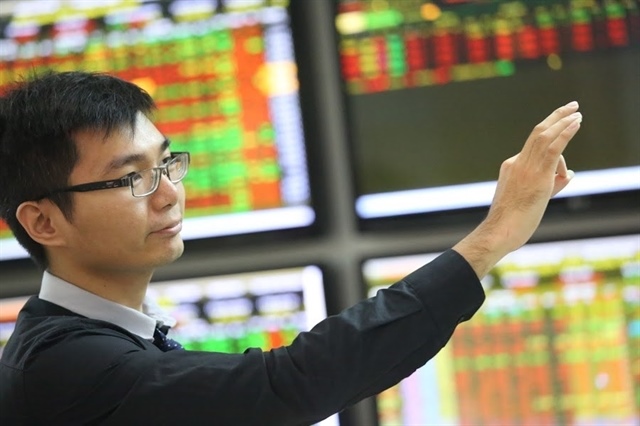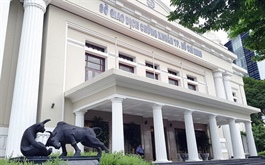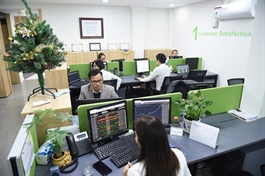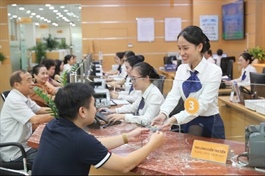Market faces short-term pressure, but long-term outlook remains bright
Market faces short-term pressure, but long-term outlook remains bright
The market has gained around 30 per cent this year, with daily liquidity frequently exceeding US$1 billion, placing Việt Nam among the most vibrant markets in Asia.

An investor in a trading room of a securities firm in Hà Nội. — VNA/VNS Photo |
Việt Nam's stock market is entering a period of short-term fluctuation, but analysts and fund managers maintain a strongly positive long-term outlook, citing solid macroeconomic foundations, improved corporate earnings and ongoing capital market reforms.
The market has gained around 30 per cent this year, with daily liquidity frequently exceeding US$1 billion, placing Việt Nam among the most vibrant markets in Asia. The country's economic momentum has also been notable as it recorded 7.9 per cent GDP growth in the first nine months of 2025.
Despite this favourable backdrop, foreign investors have continued to sell, creating what appears to be a paradox between market performance and capital flow.
According to Thiều Thị Nhật Lệ, CEO of UOB Asset Management (UOBAM) Vietnam, the persistent net selling is driven primarily by currency pressure.
The Vietnamese đồng has depreciated more than many other regional currencies, such as the Japanese yen, Singaporean dollar, Malaysian ringgit and Thai baht, eroding foreign investors' returns when measured in their home currencies.
Lệ attributed the outflow to Việt Nam's current 'frontier market' status, which limits its weighting in global portfolios. As a result, large institutional investors tend to treat Việt Nam as a tactical opportunity rather than a long-term core allocation, according to Lệ
Market expectations surrounding the potential upgrade to 'emerging market' status have grown, but asset managers caution that the impact will not be immediate.
Under FTSE Russell's schedule, the classification would only take effect in September 2026, which is when passive funds begin adjusting their portfolios.
Active funds, meanwhile, will require additional time to establish accounts and operational structures before deploying capital. The optimistic sentiment surrounding the upgrade remains well-founded, but its material effect will unfold only gradually.
Even so, confidence among long-term investors remains strong.
Deputy CEO of VinaCapital Nguyễn Hoài Thu said that some of the foreign outflows stemmed from rebalancing rather than fundamental concerns.
Strategic shareholders had been reducing holdings in favour of domestic investors, and several passive and index-tracking funds had taken profits after the market's rapid rise.
Thu emphasised that these dynamics did not diminish the country's long-term investment story.
She highlighted that listed companies' earnings per share were expected to grow 23 per cent in 2025, with a compound annual growth rate of about 16 per cent projected for 2026 and 2027.
Valuations also remained attractive, with the market trading at a forward price-to-earnings ratio of roughly 10.5 times if a small group of high-growth stocks was excluded.
Macroeconomic conditions continue to reinforce this outlook. UOBAM Vietnam forecasts GDP growth of 8–8.3 per cent for 2025, aligning with the Government's ambitious target of 10 per cent for 2026.
Structural reforms are also advancing, including the introduction of the omnibus trading account, improvements in clearing and settlement systems and the application of a central counterparty mechanism. These measures are expected to enhance transparency, efficiency and liquidity, strengthening the capital market over the long run, according to Thu.
Nevertheless, several risks still warrant attention. Exchange rate fluctuations remain a major concern, while the broader external environment, shaped by global economic uncertainty, geopolitical tensions and evolving US trade policies, could influence investor sentiment.
Interest rate trends worldwide also remain an important factor in determining capital flows.
Despite these challenges, the overarching view among institutional investors is that Việt Nam's long-term growth story remains compelling.
Thu encouraged investors to adopt a consistent long-term strategy rather than attempting to time market peaks and troughs, arguing that fundamental earnings growth would continue to drive valuations.
If foreign capital returns in force following the market upgrade and the completion of necessary operational groundwork, Việt Nam could see a strong improvement in both liquidity and market valuations during the 2026–2027 period.
- 08:45 26/11/2025
























